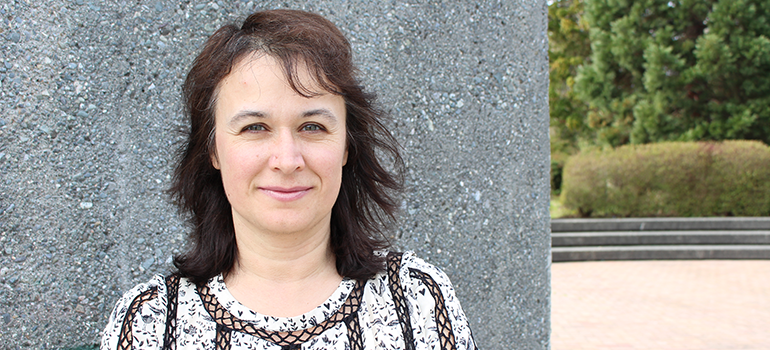
Professor Stefka Marinova-Todd, Associate Professor at UBC’s School of Audiology and Speech Sciences and Director of UBC’s Centre for Intercultural Language Studies.
On the eve of World Autism Awareness Day on April 2, Stefka Marinova-Todd, associate professor at UBC’s School of Audiology and Speech Sciences and director of UBC’s Centre for Intercultural Language Studies, debunks the perception that bilingualism hampers language development in children with autism.
Several years ago, you and your colleagues decided to examine if bilingualism interferes with language development in children with autism spectrum disorders. What did you find?
At the time, there were no other published studies on bilingual children with autism spectrum disorders (ASD), so we began with a small-scale study that compared the vocabulary size of Chinese-English bilingual children with ASD and children with ASD who spoke only English (known as monolingual). We chose to focus on vocabulary size because it’s considered to be an accurate representation of language development. We found that bilingual children with ASD acquire vocabularies that are just as rich as monolingual children with ASD, indicating that bilingualism does not have a negative effect on the language development of children with autism.
Today, as a result of this work, we know that clinicians are increasingly less likely to recommend that families of bilingual children with ASD need to stop speaking more than one language — something that was predominate advice only a few years ago!
Why did you decide to pursue this area of research?
In the courses I teach at UBC’s School of Audiology and Speech Sciences, I emphasize the cognitive, social and emotional benefits of raising children bilingually. It is important for future speech-language therapists to know that bilingualism is not detrimental to the language development of children with language delay and/or disorders. In fact, imposed monolingualism is much more likely to have negative effects on these children’s language development and socialization.
When it comes to determining the needs of bilingual children with autism, what more needs to be done?
Today, there are far more bilingual and multilingual individuals around the world than monolingual, and these numbers are constantly growing. This means that the number of bilingual patients and clients in clinical settings is constantly growing as well. Despite this growth, there is still a proportionately limited amount of research on bilingual clinical populations.
Since publishing our initial study, we have conducted another study that found no differences between monolingual and bilingual children with autism in earlier language development — the age of first words, first phrases, as well as general language abilities were no different. We also have new findings that show their story-telling skills are equivalent.
We are now working on another project that will push the boundaries a bit further and examine whether bilingual children with autism experience cognitive advantages. This phenomenon, a bilingual brain boost so to speak — has been reported in children who don’t have developmental disabilities. The results are still to come but we might find that children with autism raised bilingually experience added benefits as well, which would be very exciting news not only for us, but for their parents, teachers, and health-care providers too.
Outside of your research, you also teach students at UBC’s School of Audiology and Speech Sciences. Tell us more about your path to becoming a university professor and what you enjoy most about your role.
I was always very interested in studying foreign languages and discovering more about how people learn languages. After completing a BA with a major in Psychology from York University and obtaining my doctorate from Harvard Graduate School of Education, I started working as an assistant professor at the UBC School of Audiology and Speech Sciences in 2003. Although I am not a clinician by training, I contribute to the research and foundational education of our students by teaching them about typical language development of bilingual children, the basics of discourse analysis, and the language and literacy development and difficulties of school-age children — all of which are essential aspects of the clinician’s practice with clients with communication disorders.
I enjoy my work immensely — but perhaps what I love most is the element of discovery: to discover new knowledge through my research, but also discover something new about human nature through my interactions with my students. No one keeps me more on my toes than my students — they challenge me in a positive way, keep me motivated and up to speed on the ever-changing world of technology (who knew that “hashtag” could be used in spoken language?!). In the end, the biggest reward for me is to see their sense of accomplishment when they have just defended their thesis or completed a major assignment. Also, I love hearing back from former students, usually 5 or 6 years after they have graduated, about how the knowledge and skills they learned from me are helpful and essential in their clinical practice — I do not believe there is a better testimonial for life-long learning!
You’re also the Director of UBC’s Centre for Intercultural Language Studies. Tell us more about this Centre.
UBC’s Centre for Intercultural Language Studies (CILS) was established over 20 years ago. The Centre facilitates and promotes research and disseminates knowledge about intercultural competence and communication here at UBC. Throughout the year, we organize events on a variety of topics and invite speakers to give talks on their current research. We also organize an annual symposium, where researchers, students, and members of our community, including language teachers, speech-language therapists, language and intercultural facilitators, can present their research findings and share insights. This year, we’re hosting the CILS symposium on May 1, which is open to the public, and the theme is ‘ Bilingualism across the lifespan’.